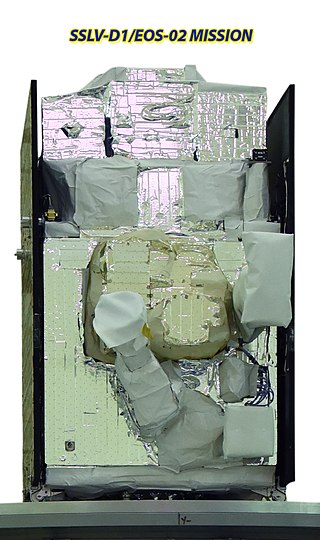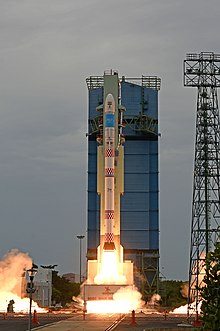
The Polar Satellite Launch Vehicle (PSLV) is an expendable medium-lift launch vehicle designed and operated by the Indian Space Research Organisation (ISRO). It was developed to allow India to launch its Indian Remote Sensing (IRS) satellites into Sun-synchronous orbits, a service that was, until the advent of the PSLV in 1993, only commercially available from Russia. PSLV can also launch small size satellites into Geostationary Transfer Orbit (GTO).

The Indian National Satellite System or INSAT, is a series of multipurpose geostationary satellites launched by the Indian Space Research Organisation (ISRO) to satisfy telecommunications, broadcasting, meteorology, and search and rescue operations. Commissioned in 1983, INSAT is the largest domestic communication system in the Indo-Pacific Region. It is a joint venture of the Department of Space, Department of Telecommunications, India Meteorological Department, All India Radio and Doordarshan. The overall coordination and management of INSAT system rests with the Secretary-level INSAT Coordination Committee.

Geosynchronous Satellite Launch Vehicle (GSLV) is a class of expendable launch systems operated by the Indian Space Research Organisation (ISRO). GSLV has been used in fifteen launches since 2001.
Rohini is a series of satellites launched by the Indian Space Research Organisation (ISRO). The Rohini series consisted of four satellites, each of which was launched by the Satellite Launch Vehicle (SLV) and three of which made it successfully to orbit. The series were mostly experimental satellites, with the first launch being in 1979. There was an earlier series of ISRO sounding rockets with the same name, first launched 1967.

The Launch Vehicle Mark-3 or LVM3 is a three-stage medium-lift launch vehicle developed by the Indian Space Research Organisation (ISRO). Primarily designed to launch communication satellites into geostationary orbit, it is also due to launch crewed missions under the Indian Human Spaceflight Programme. LVM3 has a higher payload capacity than its predecessor, GSLV.

EOS-04 or Earth Observation Satellite - 04 is an Indian Space Research Organisation Radar Imaging Satellite designed to provide high-quality images under all weather conditions for applications such as Agriculture, Forestry & Plantations, Soil Moisture & Hydrology and Flood mapping. It is a follow on to RISAT-1 satellite with similar configuration. The satellite is developed by the ISRO and it is the sixth in a series of RISAT satellites.

The Small Satellite Launch Vehicle (SSLV) is a small-lift launch vehicle developed by ISRO to deliver 500 kg (1,100 lb) payload to low Earth orbit or 300 kg (660 lb) payload to Sun-synchronous orbit. The rocket supports multi-orbital drop-offs capability for small satellites.

The PSLV-C44 was the 46th mission of the Indian Polar Satellite Launch Vehicle (PSLV) program. It was the first flight of PSLV-DL, having 2 strap-on boosters and placed a primary payload Microsat-R and a secondary payload of Kalamsat V2 in Sun-synchronous orbits.

The PSLV-C53 is the 55th mission of the Polar Satellite Launch Vehicle (PSLV) and 15th mission using PSLV-Core Alone variant. PSLV-C53 is the second dedicated commercial mission of NSIL.

EOS-02 was an Indian Earth observation microsatellite developed by the Indian Space Research Organisation as a test payload on the maiden launch of the Small Satellite Launch Vehicle (SSLV). EOS-02 was based on Microsat-TD. The objective behind EOS-02 was to realize and fly an experimental imaging satellite with short turnaround time to showcase launch on demand capability.

The PSLV-C54 was the 56th mission of the Indian Space Research Organisation's Polar Satellite Launch Vehicle (PSLV). It was launched on 26 November 2022 with the Oceansat-3 satellite and Thybolt nanosatellites of Dhruva Space from Satish Dhawan Space Centre, Sriharikota, Andhra Pradesh, India.

AzaadiSAT was an Indian Earth observation 8U Cubesat weighing around 8 kg developed by the Space Kidz India as a test payload on the maiden launch of the Small Satellite Launch Vehicle (SSLV). It was hitching a ride with EOS-02, the primary satellite of the mission. The launch on 7 August 2022 was a failure in the rocket leading to imminent return to atmosphere for the rocket and the satellites it carried, destroying them all.

The SSLV-D2 was the second mission of the Small Satellite Launch Vehicle (SSLV). The vehicle carried three payloads: EOS–07, Antaris US Firm named as Janus-01 and AzaadiSAT-2 by SpaceKidz India.

PSLV Orbital Experiment Platform (POEM) also known as PSLV Stage 4 Orbital Platform (PS4-OP) is an orbital micro-gravity test bed based on spent fourth stage of PSLV. By adding modular subsystems for power generation, communication and stabilization like photovoltaic cells, Telemetry and Telecommand (TT&C) package, attitude control system, data storage etc to the PSLV fourth stage, it can function as a satellite bus. This augmented stage can then host payloads for up to six months while in orbit, making it useful for qualifying components, gaining space heritage and conduct experiments in micro-gravity conditions. Usually the fourth stage of PSLV is discarded after deployment of satellite and remains in orbit for a significant duration in a passive state as a piece of space debris.

EOS–07 is an Earth observation satellite developed by the Indian Space Research Organisation (ISRO) and launched during the SSLV-D2 mission, the first successful mission of the SSLV rocket. It's a minisatellite designed to accommodate new technology payloads in a quick turn-around time.
EOS-08 is an experimental earth-observation Indian satellite launched on 16 August 2024.
















